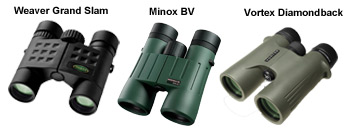
Weaver Grand Slam, Minox BV and Vortex Diamondback - 3 value model binoculars at the top of their class
There is a lot to see when you go camping, particularly in the early morning and evening when much of the wildlife is out-and-about (but the people aren’t!). A good set of binoculars can enhance your wildlife viewing experience and these three models from Weaver® (strangely, no information on their website), Minox® and Vortex® are all great binoculars, even though they are considered low to mid-range by their respective manufacturers.
Binoculars are a lot like cameras, when it comes to price and quality. Like cameras, the “sweet spot†for the average recreational user is right around $250. These three models have very bright and clear optics which are superior to most of what is available in the superstores.
It’s very difficult to compare binoculars without taking them outside and looking through them, side by side. Reviews like this can steer you in the right direction, but there can be small nuisances in the optics that might make one model better or worse, for you. They really need to be compared outside, by focusing on some distant objects and comparing the crispness of the focus, the brightness of the scene, and the field of view, or how wide the scene is at that distance.
From a technical standpoint, there is not a lot that separates these three models. The models reviewed here have a magnification of 8x and and objective lenses of 25mm (Weaver) to 42mm (Minox and Vortex). The Vortex is lightest at 25 ounces, but the heaviest (Grand Slam) is only 29 ounces. All three are about six inches long. Field-of-view at 1,000 yards ranges from 351 feet for the Grand Slam, to a whopping 420 feet for the Diamondback. The Minox comes in on the high-side, at 389 feet.
All three of these models will serve you well for many years to come. Having a good set of binoculars can really add to the camping experience, whether you are bird watching or looking for larger game. The bright, clear optics provided by these models are well worth the extra cost over lesser binoculars, and their rubberized exteriors will help protect them from the everyday bumps and drops that our camping gear tends to experience.
Do you carry binoculars when you hike?
See also…

If you want to use the binoculars to look at star clusters, the Milky Way, and the Moon, you want a large objective lens.
I have a monster pair of 11x80s for looking at the stars.
I also have a pair of 10x50s that are good for all around viewing, including the night sky. However, I don’t backpack or hike with them. The above models you mentioned have the definite advantage of light weight.
John Soares’s last blog post..Young Astrobiologist Hikers in Lassen Volcanic National Park
I feel the same way about cameras, Jim. The next giveaway at CampingBlogger is going to be a digital point-and-shoot and, man, there’s a lot of cameras to choose from in that category.
Binoculars are something I have wanted to add to my hiking kit for about a year now. Every time I head out to shop for a pair I end up coming home with something else. Maybe your post will help santa pick me out pair…